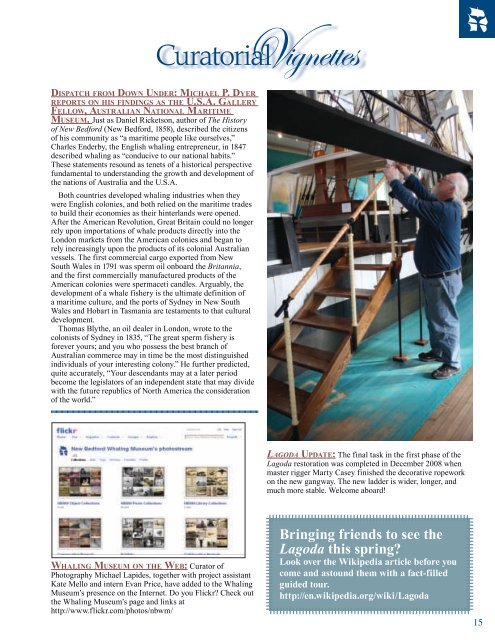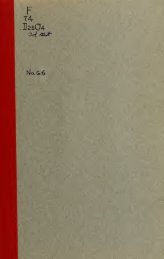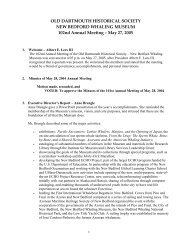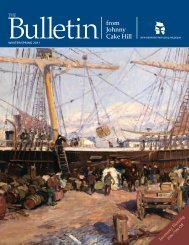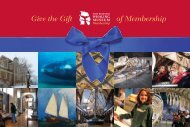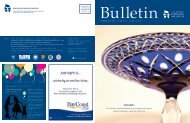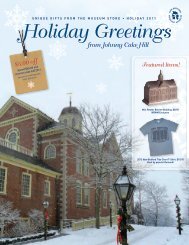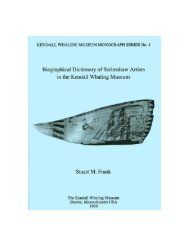IN THECOMMUNITY14<strong>New</strong> <strong>Bedford</strong> Symphony Orchestrawww.nbsymphony.org508-999-NBSO (6276)Valentine's Concert: "Aspects of Love"February 7, 2009 8:00 p.m.Eva León, ViolinDebussy : Prelude to the Afternoon of a FaunBernstein : Serenade for Violin (after Plato)Mussorgksy : Pictures at an ExhibitionPre-concert Prelude at the Z - 6:45 - 7:15 pm(free with evening ticket purchase)Spring Concert: "An Orchestral Showcase"March 28, 2009 8:00 p.m.Liszt : Les PreludesRimsky-Korsakov : Capriccio EspagnolSibelius : Symphony No 2Pre-concert Prelude at the Z - 6:45 - 7:15 pm(free with evening ticket purchase)Season Finale: "Effervescent Artistry"May 2, 2009 8:00 p.m.Richard Stoltzman, ClarinetWagner : Overture to Die MeistersingerGordon Jenkins : Goodbye,"In Memory of Benny"Copland : Concerto for ClarinetStravinsky : Petrushka Suite (1947 version)Pre-concert Prelude at the Z - 6:45 - 7:15 pm(free with evening ticket purchase)<strong>New</strong> <strong>Bedford</strong> Art <strong>Museum</strong>608 Pleasant St.www.newbedfordartmuseum.org(508) 961-3072Winter Hours: 12pm - 5pm Wednesday throughSunday. Closed Mondays & Tuesdays, and majorholidays. Admission $3 adults, $2 students &seniors, children under 17 are free and must beaccompanied by an adult.Ocean Explorium at<strong>New</strong> <strong>Bedford</strong> Seaport174 Union Streetwww.oceanexplorium.org(508) 994-5400Ocean Voice Speaker SeriesTuesday Evenings, 7 p.m.! All are invitedto dynamic lectures that make you think!See the SphereSaturdays 10-4 p.m.See the world like never before. See theSphere! This spectacular marble, floatingin space, takes you on a journey aroundthe world and beyond. Understandscientific issues on a global scale.<strong>New</strong> <strong>Bedford</strong> HistoricalSociety: Black HistoryMonth Eventswww.newbedfordhistory.org(508) 979-8828Tenth Annual Frederick DouglassRead-a-thonSunday, February 8, 20092:00 – 6:00 p.m.The First Unitarian ChurchJoin us in celebrating Black HistoryMonth with a community reading ofthe Narrative of the Life of FrederickDouglass. This event is an annualhighlight with its participation bycommunity members and schoolagedyouth.Traces of the Trade: Massachusetts andthe Economy of SlaveryThursday, February 12, 20097:00 – 9:00 p.m.SPECIAL ANNOUNCEMENT:The <strong>Whaling</strong> <strong>Museum</strong> now provides a Passportto Discover <strong>New</strong> <strong>Bedford</strong>!Now when visitors come to the <strong>Whaling</strong> <strong>Museum</strong>, they can purchasea passport that is valid for admission to the Art <strong>Museum</strong>, the Buttonwood Zoo,the Rotch-Jones-Duff House and the Ocean Explorium.Stop by the <strong>Museum</strong> and get your passport today!<strong>New</strong> <strong>Bedford</strong> <strong>Whaling</strong> <strong>Museum</strong>In commemoration of the 200 thanniversary of the abolition ofthe slave trade, MA Humanitiespresents Massachusetts and theEconomy of Slavery, featuring ascreening of Katrina Browne’sdocumentary, Traces of the Trade,which follows a Rhode Islandfamily as members discover theirfamily legacy and connections tothe Rhode Island slave trade.Book Signing and Talk:JohnStauffer, author of Giants: TheParallel Lives of FrederickDouglass and Abraham LincolnSaturday, February 21, 20093:00 – 5:00 p.m.Stauffer’s collective biographyof Douglass and Lincoln tellsa moving story of the two menwho dominated 19 th centuryAmerican life- as allies across theracial divide, friends who drewa common inspiration <strong>from</strong> hardscrabble beginnings and fellowtravelers on the road of Americanself-making. Join us for a greatdiscussion. Co-sponsored byBaker Books.<strong>New</strong> <strong>Bedford</strong> <strong>Whaling</strong>National Historical Park33 William St., www.nps.gov(508) 996-4095The National Park will be holdingtwice weekly volunteer training<strong>from</strong> February through April.Trainings will be held on Tuesdayevenings and Saturday mornings.All trainings open to any currentor potential volunteers. Fordetails, contact Emily atemily_prigot@nps.gov or call508-996-4095 x 6105.Dedication of theWhitfield-ManjiroFriendship HouseThursday, May 7, 2009<strong>Museum</strong> and Activity Centerin Fairhaven by Dr. ShigeakiHinohara of Japan. http://manjiro1.tripod.com/(508) 992-5342
DISPATCH FROM DOWN UNDER: MICHAEL P. DYERREPORTS ON HIS FINDINGS AS THE U.S.A. GALLERYFELLOW, AUSTRALIAN NATIONAL MARITIMEMUSEUM. Just as Daniel Ricketson, author of The Historyof <strong>New</strong> <strong>Bedford</strong> (<strong>New</strong> <strong>Bedford</strong>, 1858), described the citizensof his community as “a maritime people like ourselves,”Charles Enderby, the English whaling entrepreneur, in 1847described whaling as “conducive to our national habits.”These statements resound as tenets of a historical perspectivefundamental to understanding the growth and development ofthe nations of Australia and the U.S.A.Both countries developed whaling industries when theywere English colonies, and both relied on the maritime tradesto build their economies as their hinterlands were opened.After the American Revolution, Great Britain could no longerrely upon importations of whale products directly into theLondon markets <strong>from</strong> the American colonies and began torely increasingly upon the products of its colonial Australianvessels. The first commercial cargo exported <strong>from</strong> <strong>New</strong>South Wales in 1791 was sperm oil onboard the Britannia,and the first commercially manufactured products of theAmerican colonies were spermaceti candles. Arguably, thedevelopment of a whale fishery is the ultimate definition ofa maritime culture, and the ports of Sydney in <strong>New</strong> SouthWales and Hobart in Tasmania are testaments to that culturaldevelopment.Thomas Blythe, an oil dealer in London, wrote to thecolonists of Sydney in 1835, “The great sperm fishery isforever yours; and you who possess the best branch ofAustralian commerce may in time be the most distinguishedindividuals of your interesting colony.” He further predicted,quite accurately, “Your descendants may at a later periodbecome the legislators of an independent state that may dividewith the future republics of North America the considerationof the world.”LAGODA UPDATE: The final task in the first phase of theLagoda restoration was completed in December 2008 whenmaster rigger Marty Casey finished the decorative ropeworkon the new gangway. The new ladder is wider, longer, andmuch more stable. Welcome aboard!WHALING MUSEUM ON THE WEB: Curator ofPhotography Michael Lapides, together with project assistantKate Mello and intern Evan Price, have added to the <strong>Whaling</strong><strong>Museum</strong>’s presence on the Internet. Do you Flickr? Check outthe <strong>Whaling</strong> <strong>Museum</strong>’s page and links athttp://www.flickr.com/photos/nbwm/Bringing friends to see theLagoda this spring?Look over the Wikipedia article before youcome and astound them with a fact-filledguided tour.http://en.wikipedia.org/wiki/Lagoda15


